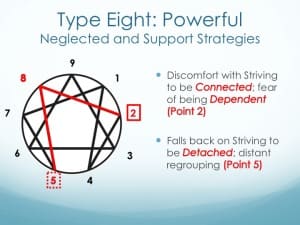
There is a saying in zen that becoming enlightened is simple:
Sit straight and breathe. And in 20 years or so you will become instantly enlightened.
Work with the Enneagram strikes me the same way. There is a lot to be said for focusing on the basics. Those basics, to me, are continuing to ask “How do I habitually misuse my preferred strategy? How can I develop more freedom from those traps so I can respond to life as it is rather than responding out of a fixated pattern?”
In zen, one counts breaths, walks deliberately, etc. as ways of training the mind before eventually letting go of those tools and entering a state of shikantaza or “just sitting.” While the “goal” is just sitting, zen adepts know that you need to practice the other techniques before just sitting is possible.
Likewise, when working with the Enneagram the mind benefits from having things to occupy it while in the process of becoming free from the habitual traps it has created–we need grist for the mill; we have to befriend and integrate that which we are to overcome. Looking at the inner lines of the Enneagram can be very useful in this regard.
By way of warning, it is very easy to become infatuated with the potential complexity in the Enneagram. I find that additional layers of complexity eventually reach a point of greatly diminished returns–it is so easy to keep seeking patterns and inter-relationships that we forget to do the hard work of paying attention to (and becoming free from) our core fixation. That said, it helps to see things from different angles to develop a deeper appreciation of them, and that is what the connecting points can do for us.
The fascinating thing about the Enneagram is that it is both a map of people and of the person. What I mean by this is that the Enneagram allows us to see the differences in people based on which of the adaptive strategies they non-consciously “prefer;” in this sense it can be used as a typology. At the same time, the Enneagram is a map of dynamics that occur within each of us–although we each have a strategy that we seem to default to (and which causes most of our problems and is the source of most of our gifts), we use all nine strategies to greater or lesser degrees and we use all of them in both adaptive and maladaptive ways. In this sense it is a map for each individual’s inner work.
I believe that the Pareto principle (to paraphrase–we get 80% of our benefit from 20% of our labor) applies to our Enneagram work and we do well to focus on our preferred strategy (that “20%” that has the biggest affect on us). At the same time, we don’t want to leave 20% “on the table” and unattended to, so it helps to also be conscious of the other strategies (or points on the diagram) as we do our work.
I find that looking at the connecting points on the diagram can be very helpful when working on our fixation (or habitual use of our preferred strategy). Before I explain how I see it, I want to be clear on what I am NOT suggesting.
I am not suggesting that we “integrate” in one direction and “disintegrate” in another, or that one point is a “security point” and another is a “stress point.” When I first learned the Enneagram two decades ago, this is how it was taught. Since then, however, most Enneagram teachers have come to realize that our internal dynamics are more complicated than this, and that we access both connecting points (or use the strategies at those connecting points) in adaptive ways and maladaptive ways. As an Ennea-type Eight, I use the strategies at point Two (“striving to feel connected”) and point Five (“striving to feel detached”) in both positive and negative ways; and sometimes I don’t use them at all when they would be the appropriate strategy to use.
I also don’t see any reason to assume the connecting points have an essentially larger role in shaping any individual’s behavior than points to which we are not connected. In other words, as an individual Eight, I don’t see any reason to see that, say, the strategy at point Four (“striving to feel unique”) may not be more of a problematic strategy for me than Two or Five. I also don’t feel the need to come up with construct-based explanation for why this might be the case, such as attempting to redraw the lines of the diagram come up with some “center-based” explanation such as Ichazo’s trifix concept or any of its derivatives. People are complex, and the Enneagram is just a model; expecting it to explain everything perfectly is to set oneself up for disappointment. In fact, I would suggest that the more detailed our model of the Enneagram is, the more restricted we can be from seeing the bigger picture of a person’s core motivations and behaviors.
I am suggesting, however, that the connecting points can be useful in helping us see the dynamics of our own preferred strategy more clearly. Working with them from this perspective also helps to integrate those strategies (use them adaptively rather than maladaptively) and become more able to use the other strategies appropriately. And this is the ultimate goal when working with the Enneagram as a map for individual growth rather than as a typology: to develop the freedom and flexibility to respond to the world as it is; to use the right strategy at the right time.
Because I am an executive coach I tend to focus on identifying the ways people trip up themselves. This allows clients remove the obstacles to growth rather than being continually hampered by habitual patterns and blind spots. Thus, the names I give the connecting points emphasize our maladaptive relationship to them. I use the term “neglected strategy” for what is typically called the “direction of integration” or “security point” to remind us that we get into trouble when we neglect that strategy at times when we should be using it. I use the term “support strategy” for the other connecting point to emphasize that we get into trouble when we habitually use that strategy to reinforce the grip of the preferred strategy. Again, we use all the strategies in both adaptive and maladaptive ways; when mapping a path for growth I purposely focus on the maladaptive applications and the relationship of the connecting-point strategies to the preferred strategy.
I’ll use point Eight as an example. People who are called Ennea-type Eights (by my working definition) are people who’s preferred adaptive strategy is “striving to feel powerful” (I am one such person). Most of our challenges are based in our habitual misuse of this strategy–we sometimes try to be powerful in the wrong way at the wrong time. Rather than seeing the world as it is and applying the appropriate strategy for the situation, the fixated Eight has a tendency to see the use of power as a solution to most situations. They then use a limited definition of what it means to be powerful and find themselves making a bigger mess than what they started with. (For more on how we get stuck in limited definitions of our strategy, refer to my article “Change–The Missing Piece.”)
On the Enneagram, the Eight is connected to points Two, which represents the strategy of “striving to feel connected,” and Five, which represents “striving to feel detached.”
The neglected strategy is “striving to feel connected.” This is not because they never connect with people–anyone who knows an Eight knows that they can be warm, big-hearted, loving, protective, etc. However, they neglect connecting to others when they are trapped in their habitual use of striving to feel powerful. They simply forget that it is not only an option, but an important strategy to use. They don’t practice empathy, they forget to see people as, well, people and it becomes easier for the Eight to become cruel and abusive (behavior we see when they are at their most fixated).
One way to think about this dynamic is that the need to feel powerful and the need to feel connected can cause cognitive dissonance in the fixated Eight: Connection to others can make them feel dependent and vulnerable; dependency and vulnerability run counter to feeling powerful; the need to feel connected gets temporarily pushed out of the psyche.
(This very human need to connect never fully goes away, but rather gets moved into the shadow of the fixated Eight. This can cause a contradiction we see in fixated Eights–aggression and assertiveness mixed with neediness in the form of demanding emotional support from others, which is a maladaptive application of strategy of feeling connected. This same dynamic happens with all the Ennea-types at their neglected strategy point–a mixture of neglect of the adaptive use of the strategy and a contradictory maladaptive use of the strategy.)
The “Support Strategy” for the Eight is “striving to feel detached.” Eights can use this strategy in adaptive ways–they are often able to set their emotions aside and view the world objectively. One of the reasons why Eights are such strong natural leaders is because they can will themselves to be unemotional and make the difficult decisions that others struggle to make. But, this ability to “will away” emotions has a downside. More than simply “neglecting” connection when it causes cognitive dissonance, they will consciously withdraw from those around them, going into their cave to brood, rejecting the support of others and plotting a solution to their problems in isolation. At an even more dysfunctional level, the Eight can use this strategy of feeling detached to actively dehumanize others, to see them as expendable pawns on the chess board of life who are there to serve the Eight’s ends.
I’ve written before about the Enneagram being like a problem-resolution protocol. It tells us where to look first–not because that is what definitely ails us, but because it is what has the highest probability of being what ails us. The most probable cause of the friction we find in our lives is a misuse of the preferred strategy, the second most probable is related to the connecting points. If we don’t find the solution there, we can continue to look at other points on the diagram.
But the Enneagram can also be used proactively. That is, we don’t have to wait for a problem to occur; we can use the Enneagram as a guide for continual growth. The first step in this work should be looking at our preferred strategy–how we distort it, how we allow those distortions to sustain maladaptive habitual patterns, how we can rewrite the strategy in a way that is more-adaptive and liberating. We can go deeper in this process when we explore how we use the strategies at the connecting points to reinforce those maladaptive patterns. We can then explore how to effectively integrate the strategies at the connecting points into our psyche independent of our preferred strategy–for the Eight, what does it mean to practice healthy connection and healthy detachment?
Working on our fixation on our preferred strategy through the lens of the connecting points creates the freedom and flexibility to start looking at the other points of the diagram more easily. There is much grist for the mill here.

Find more from Mario Sikora at www.enneagramlearning.com

